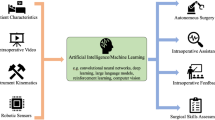Abstract
Background
In laparoscopy, impaired feedback information from the operation site and reduced instrument dexterity lead to high demands on surgeons’ skill and experience. Pre-clinical studies have shown that artificial tactile feedback (ATF) could significantly improve the quality of tactile feedback information. Additional information about interaction effects of tissue features when using ATF as well as related detection thresholds would be valuable for drawing conclusions on possible clinical application scenarios.
Objective
To identify surgical procedures in laparoscopy that could benefit from ATF in tissue examination through remote palpation.
Methods
We have developed a laparoscopic grasper capable of providing ATF by measuring the pressure distribution on one forceps jaw with a tactile sensor array. The data was presented graphically on the endoscopic screen. We conducted a study among surgeons and non-surgeons, comparing the capability to detect hidden objects through remote palpation with and without ATF. The data were analyzed using repeated-measures multiple analysis of variance (MANOVA) in two designs.
Results
ATF could enhance feedback information with significant positive effects on accuracy, speed, the reduction of the number of grasps, and user confidence. The positive effect of ATF turned out to be especially strong if hidden objects were either hard and too small or large and too soft to be recognized by remote palpation without ATF.
Conclusions
Our study contributes to the discussion on promising application scenarios of ATF-enhanced instrumentation in laparoscopic surgery. Based on our study results, such instrumentation may be valuable for detection and examination of hidden bodies or structures through remote palpation.





Similar content being viewed by others
References
Velanovich V (2000) Laparoscopic vs open surgery: a preliminary comparison of quality-of-life outcomes. Surg Endosc 14:16–21
Cuschieri A (1995) Whither minimal access surgery: tribulations and expectations. Am J Surg 169:9–19
Heijnsdijk EA, Dankelman J, Gouma DJ (2002) Effectiveness of grasping and duration of clamping using laparoscopic graspers. Surg Endosc 16:1329–1331
Gaar E (2004) Errors in laparoscopic surgery. J Surg Oncol 88:153–160
Connor S, Garden OJ (2006) Bile duct injury in the era of laparoscopic cholecystectomy. Br J Surg 93:158–168
Way LW, Stewart L, Gantert W, Liu K, Lee CM, Whang K, Hunter JG (2003) Causes and prevention of laparoscopic bile duct injuries: analysis of 252 cases from a human factors and cognitive psychology perspective. Ann Surg 237:460–469
Van de Walle P, Blomme Y, Van Outryve L (2002) Hand-assisted staging laparoscopy for suspected malignancies of the pancreas. Acta Chir Belg 102:183–186
Baumann I, Plinkert PK, Kunert W, Buess GF (2001) Vibrotactile characteristics of different tissues in endoscopic otolaryngologic surgery—in vivo and ex vivo measurements. Minim Invasive Ther Allied Technol 10:323–327
Schurr MO, Buess G, Neisius B, Voges U (2000) Robotics and telemanipulation technologies for endoscopic surgery. A review of the ARTEMIS project. Advanced Robotic Telemanipulator for Minimally Invasive Surgery. Surg Endosc 14:375–381
Puangmali P, Althoefer K, Seneviratne LD, Murphy D, Dasgupta P (2008) State-of-the-art in force and tactile sensing for minimally invasive surgery. IEEE Sens J 8:371–381
Kattavenos N, Lawreson B, Frank TG, Pridham MS, Keatch RP, Cuschieri A (2004) Force-sensitive tactile sensor for minimal access surgery. Minim Invasive Ther Allied Technol 13:42–46
Najarian S, Dargahi J, Zheng XZ (2006) A novel method in measuring the stiffness of sensed objects with applications for biomedical robotic systems. Int J Med Robot 2:84–90
Ottermo MV, Stavdahl O, Johansen TA (2004) Palpation instrument for augmented minimally invasive surgery. IEEE/RSJ Int Conf Intell Robots Syst 4:3960–3964
Westebring-van der Putten EP, Goossens RH, Jakimowicz JJ, Dankelman J (2008) Haptics in minimally invasive surgery—a review. Minim Invasive Ther Allied Technol 17:3–16
Ottermo MV, Stavdahl O, Johansen TA (2009) A remote palpation instrument for laparoscopic surgery: design and performance. Minim Invasive Ther Allied Technol 18:259–272
Schostek S, Ho CN, Kalanovic D, Schurr MO (2006) Artificial tactile sensing in minimally invasive surgery—a new technical approach. Minim Invasive Ther Allied Technol 15:296–304
Ottermo MV, Ovstedal M, Lango T, Stavdahl O, Yavuz Y, Johansen TA, Marvik R (2006) The role of tactile feedback in laparoscopic surgery. Surg Laparosc Endosc Percutan Tech 16:390–400
Acknowledgements
We cordially thank L. Mailänder MA from the Training Centre for MIS of the University Hospital Tuebingen, Clinic for General, Visceral and Transplant Surgery, for her active support in conducting the study. The research leading to these results has received funding from the European Community’s Seventh Framework Programme (FP7-ICT-2007-2) under grant agreement no. 224565.
Disclosures
Authors Sebastian Schostek, Martin J. Binser, Fabian Rieber, Chi-Nghia Ho, Marc O. Schurr and Gerhard F. Bueß have no conflicts of interest or financial ties to disclose that might pose a conflict of interest.
Author information
Authors and Affiliations
Corresponding author
Rights and permissions
About this article
Cite this article
Schostek, S., Binser, M.J., Rieber, F. et al. Artificial tactile feedback can significantly improve tissue examination through remote palpation. Surg Endosc 24, 2299–2307 (2010). https://doi.org/10.1007/s00464-010-0956-7
Received:
Accepted:
Published:
Issue Date:
DOI: https://doi.org/10.1007/s00464-010-0956-7




